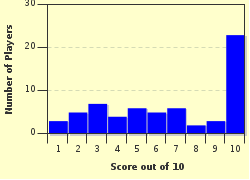Quiz Answer Key and Fun Facts
1. What kind of drum is the djembe classified as?
2. What are the three basic types of sounds / tones that can be produced with a djembe drum?
3. From which part of Africa did the djembe originate?
4. Which African ethnic group is the djembe drum commonly associated with?
5. Djembes are goblet-shaped instruments, made from wood, with an animal skin stretched across the top (where the drummer will strike).
What type of animal skin is typically used to make the drum head?
6. In making a djembe drum, it's far better to carve the drum from one single piece of wood from a hollowed out tree, as opposed to gluing slats or segments of wood together.
7. The djembe drum is also sometimes known as the "Devil drum." Why is this so?
8. The djembe drum is goblet shaped, with thin ropes / strings attached to the drumhead, and running down the side of the drum and finishing in the middle of the drum, where they are wound between, or around, metal rings.
These ropes are important because they play an important part in the tuning of the djembe. How might one go about tuning a djembe?
9. According to African legend, the djembe drum was given to the people by a mythological type of creature. What type of creature was believed to have brought the djembe drum to the people?
10. Finally, the Africans and creators of the djembe drums say that the drum contains a certain number of spirits. How many spirits is the djembe drum believed to contain?
Source: Author
thegogga
This quiz was reviewed by FunTrivia editor
agony before going online.
Any errors found in FunTrivia content are routinely corrected through our feedback system.

